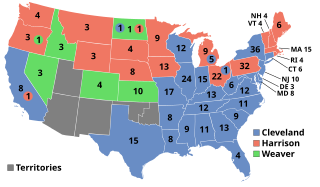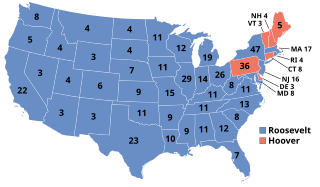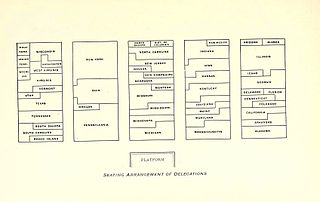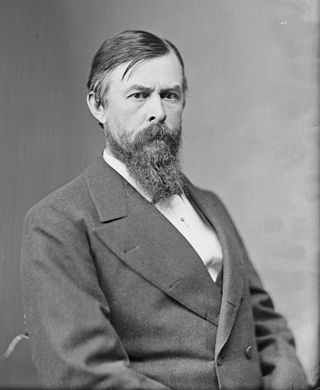
Presidential elections were held in the United States on November 2, 1852. Democratic nominee Franklin Pierce defeated Whig nominee General Winfield Scott.

Presidential elections were held in the United States on November 4, 1884. Democratic Governor Grover Cleveland of New York narrowly defeated Republican James G. Blaine of Maine. It was set apart by mudslinging and personal allegations that eclipsed substantive issues, such as civil administration change. Cleveland was the first Democrat elected president of the United States since James Buchanan in 1856, the first to hold office since Andrew Johnson left the White House in 1869, and the last to hold office until Woodrow Wilson, who began his first term in 1913. For this reason, 1884 is a significant election in U.S. political history, marking an interruption in the era when Republicans largely controlled the presidency between Reconstruction and the Great Depression.

Presidential elections were held in the United States on November 8, 1892. In the fourth rematch in American history, the Democratic nominee, former president Grover Cleveland, defeated the incumbent Republican President Benjamin Harrison. Cleveland's victory made him the first president in American history to be elected to a non-consecutive second term, a feat not repeated until Donald Trump was elected in 2024. The 1892 election saw the incumbent White House party defeated in three consecutive elections, which did not occur again until 2024.

Presidential elections were held in the United States on November 3, 1896. Former Governor William McKinley, the Republican nominee, defeated former Representative William Jennings Bryan, the Democratic nominee. The 1896 campaign, which took place during an economic depression known as the Panic of 1893, was a political realignment that ended the old Third Party System and began the Fourth Party System.

Presidential elections were held in the United States on November 8, 1904. Incumbent Republican president Theodore Roosevelt defeated the conservative Democratic nominee, Alton B. Parker. Roosevelt's victory made him the first president who ascended to the presidency upon the death of his predecessor to win a full term in his own right. This was also the second presidential election in which both major party candidates were registered in the same home state; the others have been in 1860, 1920, 1940, 1944, and 2016.

Presidential elections were held in the United States on November 3, 1908. Republican Party nominee William Howard Taft defeated threetime Democratic nominee William Jennings Bryan. Incumbent President Theodore Roosevelt honored his promise not to seek a third term, and persuaded his close friend, Taft, to become his successor. With Roosevelt's support, Taft won the presidential nomination at the 1908 Republican National Convention on the first ballot. The Democratic Party nominated Bryan, who had been defeated twice previously, in 1896 and 1900, by Republican William McKinley.

Presidential elections were held in the United States on November 4, 1924. Incumbent Republican President Calvin Coolidge won election to a full term. Coolidge was the second vice president, after Theodore Roosevelt, to ascend to the presidency and then win a full term.

Presidential elections were held in the United States on November 6, 1928. Republican former Secretary of Commerce Herbert Hoover defeated the Democratic nominee, Governor Al Smith of New York. After President Calvin Coolidge declined to seek reelection, Hoover emerged as the Republican party's frontrunner. As Hoover's party opponents failed to unite around a candidate, Hoover received a large majority of the vote at the 1928 Republican National Convention. The strong state of the economy discouraged some Democrats from running, and Smith was nominated on the first ballot of the 1928 Democratic National Convention. Hoover and Smith had been widely known as potential presidential candidates long before the 1928 campaign, and both were generally regarded as outstanding leaders. Both were newcomers to the presidential race and presented in their person and record an appeal of unknown potency to the electorate. Both faced serious discontent within their respective parties' membership, and both lacked the wholehearted support of their parties' organization.

Presidential elections were held in the United States on November 8, 1932. Against the backdrop of the Great Depression, incumbent Republican President Herbert Hoover was defeated in a landslide by Democrat Franklin D. Roosevelt, the governor of New York and the vice presidential nominee of the 1920 presidential election. The election marked the effective end of the Fourth Party System, which had been dominated by Republicans, and it was the first time since 1916 that a Democrat was elected president.

Daniel Lindsay Russell Jr. was an American politician who served as the 49th governor of North Carolina, from 1897 to 1901. An attorney and judge, he had also been elected as state representative and to the United States Congress, serving from 1879 to 1881. Although he fought with the Confederacy during the Civil War, Russell and his father were both Unionists. After the war, Russell joined the Republican Party in North Carolina, which was an unusual affiliation for one of the planter class. In the postwar period he served as a state judge, as well as in the state and national legislatures.

The 1896 Democratic National Convention, held at the Chicago Coliseum from July 7 to July 11, was the scene of William Jennings Bryan's nomination as the Democratic presidential candidate for the 1896 U.S. presidential election.

The 1916 United States Senate election in Minnesota took place on November 7, 1916. It was the first election for either class of U.S. senators held in Minnesota after the ratification of the Seventeenth Amendment to the United States Constitution, which established the popular election of United States senators. Incumbent Senator Moses E. Clapp was defeated in the Republican primary election by former American Bar Association president Frank B. Kellogg. Kellogg went on to defeat former St. Paul Mayor Daniel W. Lawler of the Minnesota Democratic Party, and Prohibition Party challenger Willis Greenleaf Calderwood, in the general election.

The 1972 North Carolina gubernatorial election was held on November 7, 1972. Republican nominee James Holshouser defeated Democratic nominee Skipper Bowles with 51% of the vote. Holshouser thus became the first Republican elected governor of the state since 1896.

The 1938 Massachusetts gubernatorial election was held on November 8, 1938.

The 1876 Prohibition National Convention was a presidential nominating convention held at Halle's Hall, in Cleveland, Ohio on May 17, 1876, to select the Prohibition Party's presidential ticket for the 1876 presidential election.

The 1904 North Carolina gubernatorial election was held on November 8, 1904. Democratic nominee Robert Broadnax Glenn defeated Republican nominee Charles Joseph Harris with 61.72% of the vote. At the time, Glenn was an attorney and former member of the state Senate, while Harris was a businessman and former member of the United States Industrial Commission.

The 1896 Indiana gubernatorial election was held on November 3, 1896. Republican nominee James A. Mount defeated Democratic nominee Benjamin F. Shively with 50.93% of the vote.

The 1888 North Carolina gubernatorial election was held on November 6, 1888. Democratic nominee Daniel Gould Fowle defeated Republican nominee Oliver H. Dockery with 51.97% of the vote.

William Anderson Guthrie was an American lawyer and politician. Born in Chatham County, North Carolina, he attended the University of North Carolina at Chapel Hill and served in the Confederate States Army during the American Civil War. After the war, Guthrie married and moved to Fayetteville to practice law. He located his practice to Durham in 1884.





















